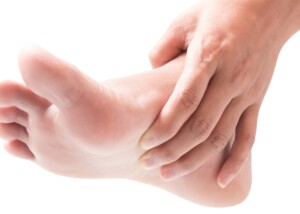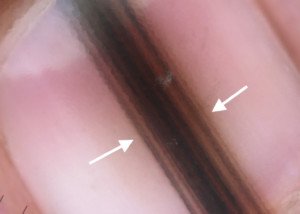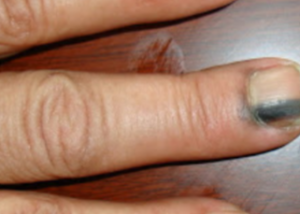
If you have diabetes and are wondering if it’s related to an unsettling black patch on your toenail, you’ll want to head straight to a dermatologist first rather than to your diabetes doctor.
A slowly growing and increasing blackness or very dark area on a toenail may be a sign of melanoma skin cancer.
However, that is not the most likely cause. But what if you DO have diabetes?
An infection called paronychia affects the nail fold and can be chronic (longstanding) or acute (sudden).
This infection is not caused by diabetes, but is more common in diabetics.
When it’s chronic, the damage to the cuticle can lead to a distortion in the underlying nail tissues.
This will then cause a space that is vulnerable to infection.
One of the microbes that can infect this space is called Pseudomonas aeruginosa.
It is this microorganism that has the potential to give the nail an almost black (more likely a blue-black) color.
Another microbe, Fusarium, can cause a blackish patch in a toenail.
“Black toenails in a diabetic can happen when the foot has suffered a lack of oxygenated blood and necessary nutrients,” says J. Mark Anderson, MD, DABFM, of Executive Medicine of Texas and who is board certified in family medicine.
“This causes the toenail to die,” adds Dr. Anderson. “While red can be a sign of acute infection, brown and black are often a sign of permanent damage.”
Melanoma Can Turn a Toenail Black
“In rare cases, a black toenail, not related to the above listed conditions or to trauma (bruising), can be due to skin melanoma [below] that is actually under the nail bed,” says Dr. Anderson.
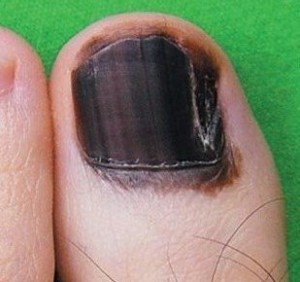
Typically, though, it’s not the entire nail, but can be most of it (below).
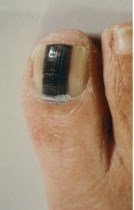
A hematoma (blood collection) can result in a “black” toenail.
Normally this is caused by either a blunt trauma (something falling on the foot) or prolonged sport or exercise activity such as hiking downhill in footwear that’s not as roomy as it should be.

Hematoma. Shutterstock/mortalpious
The darkness begins developing within a day or two of the trauma.
“Diabetics should always take time to look at their feet,” says Dr. Anderson.
“The color of feet, toes and even toenails can be a sign of uncontrolled diabetes which leads to organ damage and circulatory issues.
“Diabetes is not the only cause of black toenails. Liver, kidney and non-diabetic circulatory disease can also lead to this problem.
“Black toenails are not normal, and if you experience this issue you should seek medical attention, including a complete physical examination with bloodwork to uncover the underlying cause.”

Dr. Anderson is coauthor of the award-winning book, “Stay Young: 10 Proven Steps to Ultimate Health,” and host of the nationally syndicated Staying Young Show which goes to podcast as Staying Young Show 2.0.
 Lorra Garrick has been covering medical, fitness and cybersecurity topics for many years, having written thousands of articles for print magazines and websites, including as a ghostwriter. She’s also a former ACE-certified personal trainer.
Lorra Garrick has been covering medical, fitness and cybersecurity topics for many years, having written thousands of articles for print magazines and websites, including as a ghostwriter. She’s also a former ACE-certified personal trainer.
.
Top image: Shutterstock/MRAORAOR
Sources
medicinenet.com/nail_discoloration/symptoms.htm
practicaldiabetes.com/wp-content/uploads/sites/29/2017/08/Ldr-Hillson-lsw.pdf
cincinnatifootcare.com/black-toenails-running-affects-toes-can/
ncbi.nlm.nih.gov/pmc/articles/PMC2987777/ diabetes black toenail
Does Fasting Glucose Reading of 106 Mean Insulin Resistance?

